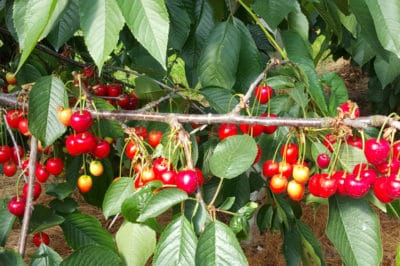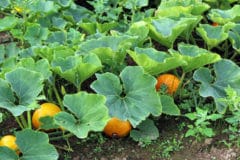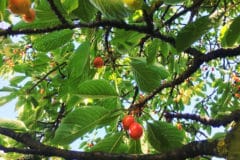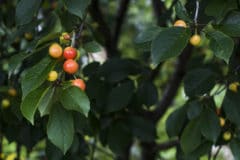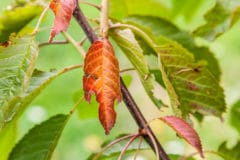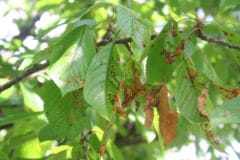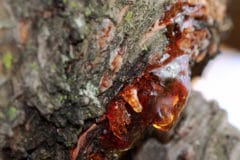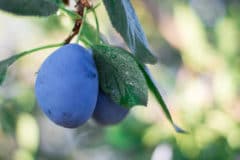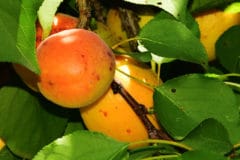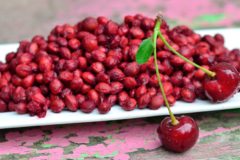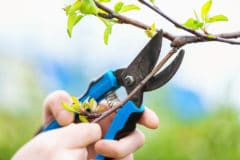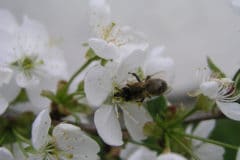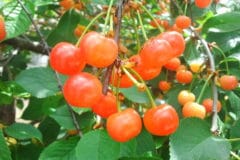What Cherry Tree Leaves Look Like
While you cannot easily tell which variety of cherry tree you have by looking at the leaves, you can determine if a tree is a cherry at all by examining its leaves.
Most cherry tree leaves have serrated edges, looking like a tiny saw blade. However, the serrations are often quite small, so look closely.
Cherry tree leaves grow on the branch staggered from one another and not opposite one another, so this is another sign to look for when trying to figure out if a tree is a cherry or some other type of tree.
The color of cherry tree leaves varies, depending on the cultivar, time of year, and growing conditions, but generally they are light to dark green or slightly coppery in color.
Cherry tree leaves also vary in shape and size. They can be long and narrow or oval in shape, but the tip of the leaves is always pointy, and the leaves are generally between 2.5 and 5 inches (6.3 and 12.7 cm) in length.
What Cherry Tree Leaves Tell You about Tree Health
Many people love eating cherries, and, unfortunately, many pests also love eating the leaves and fruit of these trees, as well.
Besides pests damaging cherry tree leaves, the condition of the leaves also reveals information about whether the tree is receiving enough water and fertilizer.
Cherry Tree Pests and Diseases
Among the most common pests and diseases affecting cherry tree leaves are:
- Taphrina cerasi, also known as witches’ broom, is a fungal disease causing broom-like clusters of twigs to grow on branches. Leaves appear earlier than normal on the brooms after blossoms fade. Control this disease by removing the brooms and burning them or disposing of them off-site.
- Cherry leaf spot is a fungus, Blumeriella jaapii, affecting cherry tree leaves. At first, older leaves develop purple spots, which later turn brown and develop into holes, followed by dropping of affected leaves. Control by removing affected leaves as soon as you see them and raking up fallen leaves at the end of the season.
- Black leaf spot, or shot-hole disease, Xanthomonas pruni, is a bacterial disease causing irregular shaped spots of purple, brown, or black color on the leaves. As the disease progresses, whole leaves turn yellow and drop from the tree. The bacteria are spread by wet conditions and can be controlled by planting trees where rain water dries quickly, by removing old and neglected stone fruit trees from the area, and by applying adequate nitrogen fertilizer each year.
- Rust is caused by the fungus Tranzschelia discolor. It appears as yellow spots on the top surface of leaves which then develop red pustules, causing the leaves to drop. Fungicide application can control this disease.
- Black cherry aphids are a common insect infecting cherry tree leaves. Clusters of small, dark insects gather on leaves, sucking nutrients and moisture and leaving a sticky honeydew residue. Infected leaves curl and become stunted in growth. Fruit can also be damaged by this pest. Attracting natural predators, such as ladybugs, lacewings, and syrphid flies is a helpful control for this pest.
- Cherry slugs, Caliroa cerasi, are another insect pest of cherry tree leaves. This pest is the larvae of the black sawfly, feeding on the leaves until nothing but the veins remain. Control this pest by hosing them off of the tree with a strong jet of water and by applying a horticultural glue to the tree trunk to stop them from climbing from the soil into the tree.
Other Cherry Tree Leaf Problems
Irrigation, fertilizer, and general care of cherry trees also affects the health of the tree and the appearance of the leaves.
Cherry trees require deep, regular irrigation during the growing season. Lack of water causes leaves to wilt, yellow, and eventually fall from the tree. Unless it rains, water trees every 10 to 14 days during the late spring and summer months.
Cherry trees also need an annual application of a balanced fertilizer containing nitrogen, potassium, and phosphorus. The trace mineral zinc is also important for the good health of cherry trees. Inadequate fertilizer results in yellowing or other discoloration of leaves, as well as poor quality fruit.
